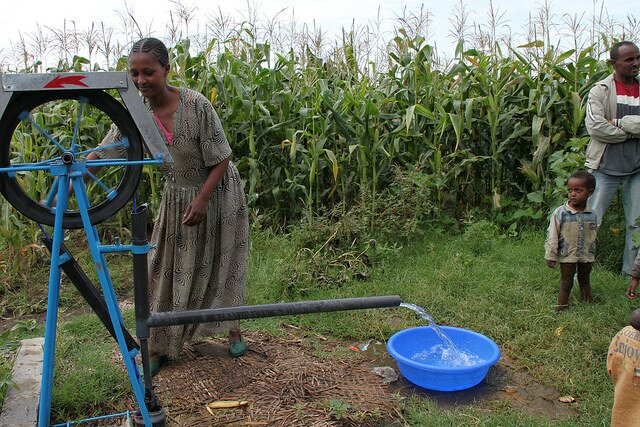By Elizabeth Kurylo
Communications manager, International Trachoma Initiative
Every morning and every night, I turn on the hot and cold water taps, adjusting them so the temperature is just warm enough to wash my face. I take for granted that the water will flow. I would be shocked if it didn’t. This easy access to water is a luxury not enjoyed by hundreds of millions of people around the world.
As we mark World Water Day, it is worth noting that 748 million people do not have access to an improved source of drinking water and 2.5 billion do not use an improved sanitation facility. For them, the lack of water can mean poor health, disability and even death.
Water and sanitation is especially important in the prevention and control of trachoma and other neglected tropical diseases (NTDs). Trachoma is an ancient eye disease caused by a bacterial infection. Left untreated, it can lead to blindness. But we can stop it with the World Health Organization-endorsed SAFE strategy – Surgery, Antibiotics, Facial cleanliness and Environmental improvement.
Water is crucial to facial cleanliness, and key to ending blinding trachoma. But in many places where trachoma is endemic, water is scarce, and rationed for uses other than hygiene, such as cooking. Face washing is not a priority.
The global trachoma community has made much progress since 1998, when Pfizer began donating the antibiotic Zithromax®, which treats and prevents trachoma. More than 444 million doses of Zithromax® have been shipped to trachoma endemic countries to date. And seven countries have reported reaching their elimination goals.
Under the leadership of WHO and the Alliance for the Global Elimination of Blinding Trachoma by the year 2020 (GET 2020), national trachoma programs have steadily scaled up implementation. In 2014, WHO’s Weekly Epidemiological Report (WER) said trichiasis surgeries and antibiotic distribution were tenfold higher in 2013 compared to 2004.
The International Coalition for Trachoma Control (ICTC) has galvanized the global trachoma community’s commitment to reaching elimination by 2020. Collaboration on game-changing initiatives with governments, health officials and trachoma endemic communities has led to the mobilization of more than 150 million dollars of new funding from DFID, USAID and the Queen Elizabeth Diamond Jubilee Trust. That is in addition to the national government domestic budget allocations and support already provided by many non-governmental development organizations as well as other donors such as the Lions Clubs International Foundation, Conrad N Hilton Foundation and the Bill & Melinda Gates Foundation. The WASH sector also is collaborating with the NTD sector to achieve shared goals of improving health and eliminating disease.
Still, there is much work to do. An estimated 232 million people in 51 countries live in trachoma endemic areas. Globally, 31 countries are implementing the SAFE strategy to eliminate trachoma, which signifies that 20 countries are still in need of help.
In 2015, ITI plans to ship 115 million doses of Zithromax®, donated by Pfizer. That is more than twice the amount approved for shipment in 2014. “We are doing everything we can to accelerate access to Zithromax® needed by people who are at risk of blindness from trachoma,” said Dr. Paul Emerson, Director of ITI. “We are empowering national programs so that those at risk of going blind from trachoma can be treated.”
Empowering people in trachoma endemic communities to prioritize water for hygiene also has lasting benefits. I saw this in Ethiopia, where I met Amarech Haluka, the mother of three young girls, one of whom had experienced the pain of trachoma. Health workers introduced the SAFE strategy to Amarech’s community, which received donated Zithromax® and education about the importance of using latrines and keeping their faces clean to avoid trachoma. Amarech and her husband got a loan to install a water pump in their back yard, and she now routinely washes her children’s faces twice a day. Even though she cannot adjust the temperature of the water that flows from her pump, her children’s faces are clean, and her family is free of trachoma.

